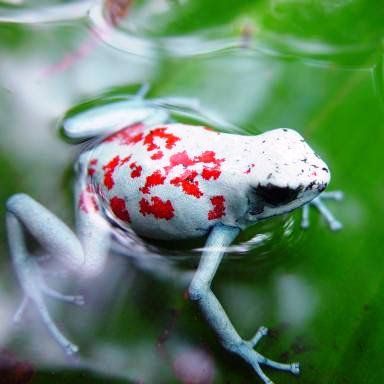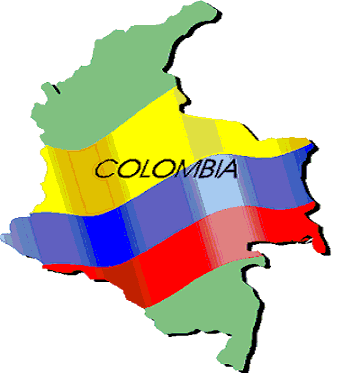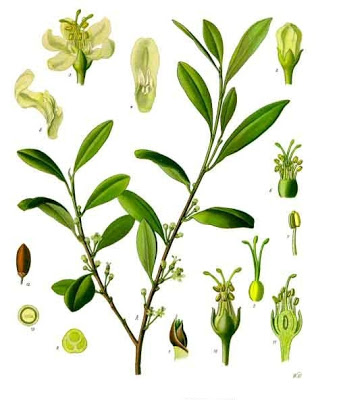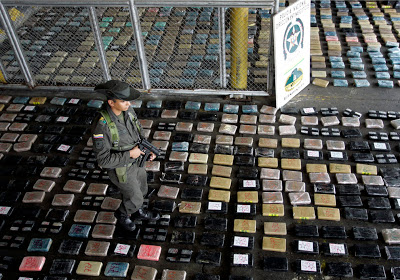The U.S. and the Colombian invasion:
A history of corruption, cocaine, and paramilitary violence
By Marion Delgado / The Rag Blog / December 7, 2009
CARTAGENA DE INDIES, Colombia — Well, kids, answering our own question from last week, it turns out that there is corruption within the Colombian military!
It’s not just the shake-downs, rip-offs, and small time bribery that are so much a part of daily life throughout the third world; in Colombia there is big time corruption, much of it encouraged and supported by U.S. government departments and agencies using your tax dollars. In some cases one part of the U.S. government pays to support one “side” and another agency pays their opponents. All’s fair in corruption as long as the goal is to get your money into the pockets of one or another “official.”
I want to focus on two types of military corruption this week. One involves cocaine production and transportation. You had to kind of know about this already, just by walking down to the corner or calling your favorite delivery service to get your share of the high quality “Cartagena marching powder” that has been in uninterrupted, steady supply since the early 80’s.
The other type is more esoteric and you might only be aware of it if you are very familiar with the civil war that’s been going on here for at least four decades, with roots that can be traced back to 1948 — or even earlier — if one studies Colombian political history.
First: cocaine, corruption and cartels
(They are not who you think they are.)
“Cocaine smugglers have infiltrated senior levels of the Colombian army, impeding efforts at fighting drugs,” Defense Minister Juan Manuel Santos has said. The country’s cocaine cartels have bribed officials “at a high level” into sharing information that has helped bosses of these illegal groups avoid capture, Santos told reporters. Colombia remains the world’s biggest exporter of cocaine, despite billions of dollars in mostly military aid from Washington aimed at stamping out the trade. “Unfortunately, the infiltration has impeded us from capturing some of the big fish we had been investigating,” Santos added. D’oh!
Implicated in the latest scandal is Diego Montoya Sanchez, aka “Don Diego,” head of the Norte del Valle cartel, accused of exporting hundreds of tons of cocaine to the United States. U.S. nose candy consumption is estimated at between 500 and 1500 tons a year, depending on which government figures are used. (For a better estimate, add up your own yearly use and multiply by 60 million.)
Investigators say Montoya recruited army officers to provide him with protection and help plan the breakout of his brother, Eugenio Montoya, who has been in a high-security prison since early in 2009.
Last year, 10 anti-narcotics police, specially trained with your money, were gunned down by Colombian soldiers supported by your money and also in the pay of drug traffickers, near the western town of Jamundi, prosecutors charge.
On August 26, 2007, Colombian media reported that members of the Norte del Valle cartel had been bribing military and police units to deactivate radar units to allow the gang to ship marijuana and cocaine from Colombia. The newspaper El Tiempo reported that the Colombian Navy had been the most infiltrated through bribes ordered by Diego Montoya and his henchmen.
The newspapers also revealed the possible involvement of the top Admiral of the Colombian Navy, Gabriel Arango Bacci, who used his influence to support drug cartels. Documents found by Colombian authorities in the possession of a smuggler known only as “Lord of the Horseshoe,” and bearing his “mark,” or logo, also had the personal classification stamp of the Admiral. The Admiral’s fingerprint was found on a receipt bearing the same logo and attesting to the transfer of $115,000 dollars from the “Lord” to the Admiral. Two other Admirals and several other high-ranking naval officers have recently been arrested in the scandal. The classified documents were flight routes to be used by the Norte del Valle Cartel on both the Pacific Ocean and Caribbean Sea coasts, through Ecuador, Panama, Colombia, and Venezuela.
This past Thursday, December 3, the Colombian Supreme Court found retired Admiral Arango innocent on appeal of ties to the paramilitary and drug traffickers, due to a lack of evidence. The Court ordered the Prosecutor General to investigate the alleged false testimony supplied by witnesses in the case. Former Defense Minister Juan Manuel Santos and current Navy Commander Guillermo Barrera are among witnesses that will be investigated.
In 2008, military tribunals found Bacci guilty of receiving U.S. $115,000 for selling the coordinates of Navy patrols to drug traffickers, so the traffickers could avoid authorities and get their drugs out of Colombia safely. Bacci requested a civil hearing before the Supreme Court.
The Supreme Court reprimanded the U.S. Ambassador to Colombia William Brownfield in November for what they termed “undue interference” in the case, after Brownfield announced that there was clear evidence linking the retired Admiral to drug traffickers. The Supreme Court said Brownfield had no jurisdiction to comment on matters of civil justice.
Arango Bacci maintains his innocence and says he is the victim of a plot to discredit him.
Montoya Sanchez (Don Diego) was captured on September 10, 2007, by Colombian authorities in a rural area of the municipality of Zarzal in Valle del Cauca state. He was accompanied by his mother and some 17 other close relatives.
On May 19, 2008, Carlos Holguin, a former Colombian Interior Minister and Justice Minister, announced that “Don Diego,” together with some prominent paramilitary leaders, would be extradited to the United States. The extradition would take place in “the coming few days”, said the Minister.
Seven months later, on December 12, 2008, Montoya was finally taken to Miami on a D.E.A. helicopter. He appeared in court on December 15, facing 12 charges including drug trafficking, obstruction of justice, money-laundering, and murder.
The North Valley cartel is believed by some to be the most powerful and violent drug trafficking organization in Colombia. The cartel reportedly relies heavily for protection on illegal armed groups, from right-wing paramilitaries to leftist rebels.
On October 21, 2009, a federal judge sentenced Montoya to 45 years in prison. Approving the sentence, Judge Cecilia Altonaga also ordered Montoya to pay $500,000 in restitution to the family of Jhon Jairo Garcia, a long-time associate of Montoya who was kidnapped, tortured and murdered by the cartel in 2003. The prosecution had said Montoya ordered the killing of Garcia after accusing him of becoming an informer for U.S. enforcement agencies. Mr. Garcia’s dismembered body was found in a river near the Colombian city of Cali.
Rather than regale you with a litany of examples of the cocaine corruption in the Colombian military. I’ve concentrated on the Montoya case because it shows the breadth of it all — and that the corruption goes to the top echelons of the military.
Not only were the brass corrupted, but bribes were paid to the right-wing Autodefensas Unidas de Colombia or AUC (United Self-Defense Groups of Colombia) and the left-wing Fuerzas Armadas Revolucionarias de Colombia — Ejército del Pueblo, (FARC or FARC-EP; Revolutionary Armed Forces of Colombia — Peoples Army.)
Too much trouble over this plant — just legalize it already.
Corruption related to the white powder known as “girl” on the streets of Detroit isn’t limited to the Colombian military. The “hidden hand” of greed has also grabbed U.S. servicemen and officers by the balls.
When a fishing boat used to smuggle cocaine was intercepted in January 2006 by the Colombian coast guard, in a region Admiral Arango oversaw, investigators found navigational charts on board that showed not only the positions of U.S. vessels, but also those of warships from Britain, the Netherlands, and Colombia.
Colombia doesn’t track U.S., British, or Dutch vessels, leaving open the possibility that there may also be a leak from U.S. anti-drug intelligence sources. The U.S. Embassy in Bogotá wouldn’t discuss the case or say whether it was investigating.
At U.S. Southern Command in Florida, American headquarters for U.S. military operations in Latin America, a spokesman said the military was unaware of any investigation into the allegations. The spokesman, Jose Ruiz, said security measures were tight at an interagency anti-drug task force in Key West, FL, that coordinates anti-drug monitoring in the Caribbean for the United States and its allies, including Colombia. The Joint Interagency Task Force-South (JIATF-S), run by the Defense Department, “has very stringent and effective security measures,” Ruiz said, “and as of today, we have no reason to believe that [they] have been compromised.”
Four U.S. soldiers serving on anti-narcotics missions in Colombia are being held on charges of drug trafficking after the discovery of 35 pounds (15 kg) of cocaine on a military aircraft. The four, who haven’t yet been publicly identified, were arrested at the end of March when their plane landed in Texas after taking off from southern Colombia. A fifth man was released. (Snitch?) Colombian authorities are investigating to see if other members of the U.S. or Colombian military were involved.
William Wood, the former U.S. ambassador in Bogotá, said the four would not be extradited even if it was proved they had committed crimes on Colombian soil. He said a three-decade old agreement gave immunity to U.S. soldiers serving in Colombia, but stressed, “We do not tolerate corruption.” lol
The four busted soldiers are among about 1,000 U.S. military and private contractors in Colombia, providing training, supplying intelligence, and helping run aerial spraying, or “fumigation” missions, (actually airborne herbicide dispersal of glyphosate, known as Roundup® in the U.S.).
And in the U.S. Officer Corps…
The case of Colonel James Hiett, former commander of U.S. Army anti-drug advisors in Colombia, found guilty of covering up his wife’s drug smuggling, is an international embarrassment to the United States. Its outlines have been widely reported. In the mid-1990s, while Hiett was stationed in the U.S., his wife, Laurie Ann Hiett, was treated in an Army hospital for drug addiction.
Later, Hiett was named to head a 200-strong battalion of U.S. military advisors in Bogotá. (WTF?) The couple went — though Laurie had lapsed back into “addiction,” even snorting coke in front of her husband. Soon she was buying cocaine through her Army-employed Colombian driver. By 1998 she was under investigation by the Army, not only for using drugs, but for shipping $700,000 worth of powder, wrapped in brown paper, to the States in diplomatic mail.
She handed some of the cash proceeds, collected on trips to New York, to her husband — who proceeded to carefully spend the wad on household bills, to “dissipate,” in his own words, ”the money trail.” Laurie Hiett pleaded guilty to smuggling and was sentenced to five years in federal prison. The Colonel was dropped from Army personnel rolls and will lose his pension. A federal judge sentenced him to five months in prison, five months home arrest and one year of probation.
Hiett’s corruption itself isn’t necessarily unusual. Former U.S. Ambassador to El Salvador and Paraguay Robert White told Salon‘s Jeff Stein, “There’s always been a fear of this by sensible people in the Pentagon. The legend is that the United States military is incorruptible, but that has proven not to be the case. There are quite a few instances.”
With the addition of thousands more U.S. troops, officers, and civilian mercenaries to the cesspool of cocaine corruption, there are sure to be more instances. Remembering the Iran/Contra coke-for-guns trades of the past, we can only hope for cheaper “Contra coke” in the future, to help the U.S. through the tough economic times of today!
Corruption of another kind, more deadly to our troops
Rebels from the FARC obtained reports about Army operations against guerrilla commanders in the far south, officials say. So far, two lieutenant colonels in the army have been arrested, as have four majors and a noncommissioned officer — for supplying the info.
The episodes, some of which have been outlined in the Colombian press in the past month, represent the most serious cases of infiltration in recent years and are a blow to a military that depends on U.S. funds and training. The U.S. has provided $5.4 billion in mostly military aid to Colombia this decade, making the country the biggest recipient of American support outside of the Middle East.
In interviews, Defense Minister Juan Manuel Santos and the commanders of the armed forces said that the breaches were discovered by military counterintelligence operatives and the evidence was turned over to the attorney general’s office, which has opened several investigations. While other cases of infiltration have been discovered in the past, officials suggested that those cases were often not investigated properly.
“From the beginning, I’ve said we have to see how penetrated we are,” said Santos, a civilian who headed the Defense Ministry for 3 years. “The situation is a penetration of some sectors of the military forces, and it’s a small percentage of the forces. We cannot say it’s generalized.”
Selling military information to FARC or ELN is nothing new, it has been going on forever, with each new revelation always described as the “most serious” and the disclaimer that only a small minority is involved, much like stories of police corruption in the U.S. that always add, “most of the force is honest.”
Santos added that he has sacked about 150 officers during his tenure, many of whom were suspected of corruption or ties to illegal armed groups. He said investigators are continuing to search for moles in the ministry.
More disconcerting is the military web of corruption that leads directly to AUC.
A short history of AUC
Colombia has a long history of privately financed self-defense groups, usually suffused with their wealthy patrons’ right-wing beliefs. These groups’ numbers began to grow rapidly in the 1980s. The growth coincided with the advent of Colombia’s drug trade. Newly wealthy drug traffickers laundered their profits by buying up as much as 2.5 million acres in northern Colombia. These new landholders put together private armies to deal with the guerrillas who kidnapped and extorted wealthy ranchers in the area. One of the first, and most feared, was a group calling itself “Death to Kidnappers” (Muerte a Secuestradores, or MAS), active in the Magdalena Medio region of north-central Colombia.
With funding from drug traffickers and other large landholders, and close and open collaboration with Colombia’s armed forces, such paramilitaries gained strength throughout the 1980s. Their tactics — selective assassinations and forced disappearances, massacres, forced displacement of entire populations — quickly made them one of the country’s main human rights abusers. They also played a strong role in the decimation of the Patriotic Union political party.
The abuses of groups like MAS caused paramilitaries to be declared illegal in 1989. Little was done to disband them, though. Human rights groups have documented widespread post-1989 collaboration between Colombia’s armed forces and paramilitary groups.
In the early 1990s the United Self-Defense Forces of Córdoba and Urabá (ACCU), a group headed by brothers Carlos and Fidel Castaño, emerged in northwestern Colombia. Using extreme brutality toward civilian populations, the group grew to be a powerful player in the northern regions of Colombia. Fidel Castaño was probably killed by guerrillas in 1995.
By 1997, Carlos Castaño had organized the ACCU and several other paramilitary groups throughout the country into a national structure, the AUC. The group grew rapidly, from perhaps 4,000 members in 1998 to a reported 13,000 in 2002. By the time its last declared members demobilized in 2006, however, their number had reached about 32,000.
The AUC was more of a loose, fluid confederation than a unified structure. It even dissolved momentarily in 2002, when Carlos Castaño briefly resigned from the leadership because “everyone does as he wishes.” Divisions within the group over links to the drug trade worsened during the early 2000s, exacerbated by the U.S. Justice Department’s requests to extradite AUC leaders for narcotrafficking and the State Department’s inclusion of the AUC on its list of international terrorist groups.
At the same time, a new wave of individuals with long histories as narcotraffickers began entering AUC’s top leadership. Leaders like Diego Fernando Murillo (“Don Berna“), Victor Manuel Mejia (“El Mellizo“), and Francisco Javier Zuluaga (“Gordolindo“) moved from Colombia’s drug underworld to commanding key paramilitary blocs.
After several years of divisions, including increasing incidents of combat between groups (particularly in Magdalena and Casanare), the interests that had funded AUC became more adequately represented by blocs than by one singular banner. Several prominent paramilitary leaders died at the hands of fellow paramilitaries in 2004: Carlos Castaño in April, “Rodrigo 00” of the now-defunct Metro Bloc in June, and Miguel Arroyave of the Centauros Bloc in September.
After Carlos Castaño, the most publicly recognized leader of the AUC was Salvatore Mancuso. A former Córdoba rancher, Mancuso became the “Maximum Comandante” of the AUC and chief negotiator in Santa Fe de Ralito. Mancuso was the first top AUC leader to testify under the Justice and Peace Law.
Corruption, AUC, and the U.S. Army
In May 2005 Colombian authorities arrested Lieutenant Colonel Alan Norman Tanquary and Sergeant Jose Hernandez, of the United States Army, for illegally trafficking weapons and ammunition. The arms — according to press reports, were more than 30,000 “projectiles” that were found in the house where the two were arrested — were almost certainly meant for sale to paramilitary groups, the right-wing death squads that terrorize Colombia’s people.
(Tanquary was reported to be a Lieutenant Colonel by Colombia’s RCN radio shortly after the arrest. U.S. media have since identified him as an Army Warrant Officer. We don’t know if he was a Lt. Colonel or a Warrant Officer because he was never tried, in Colombia or in the U.S.)
The U.S. Embassy and its bosses back home have kicked into damage control mode, and are trying to sweep this one under the rug. And so far, the U.S. media isn’t doing much to stop them. U.S. soldiers in Colombia supposedly have two goals — to combat production of cocaine, and help end the 40-year-old civil war. In 2005, five U.S. soldiers were caught smuggling coke back to the United States, and now more soldiers, one of them a Lieutenant Colonel, no less, have been found helping and profiting from the most brutal force in the hemisphere.
The U.S. often justifies its aid (nearly $800 million this year) to a military known to collaborate and work closely with paramilitary groups by saying it is helping the Uribe government clean up the army; like the U.S. presence there is a magical cure for corruption and human rights abuses. Such fantasies may not survive many more incidents like this one.
Some questions
How did the American troops manage to strike these deals? It’s not as though U.S. soldiers in Colombia are being pursued by members of the paramilitaries pestering them to run drugs and arms for them. This money-making opportunity will only knock if someone else first makes the introduction. Who, then, is helping corrupt Americans link up with their paramilitary customers? What bridges the two degrees of separation?
Could it be that Colombian military personnel, members of U.S.-aided units that have supposedly severed their ties with the paramilitaries, help facilitate contacts with “friends” among the local paramilitaries?
Had the paramilitaries involved bought bullets from U.S. soldiers in the past? At what level of the AUC, which spreads terror throughout the country, were these deals struck?
For eight years, George Bush prattled on with his Big Lie, unsupported by any evidence, that Venezuela’s arms purchases could “end up in the hands of the FARC,” while his own soldiers were caught red-handed arming Colombia’s worst perpetrators of political violence.
What about Obama, and Hillary, and Secretary of War Gates: are they ashamed to be part of Colombia’s terrible record on human rights? Apparently not. Republicans are now urging Obama to sign a new “free trade” agreement with Colombia to go along with the already-signed Military Pact. Will he do it? You bet your sweet ass he will. I’m disgusted; anyone want to join me?
Next week: We tie it all together. The cocaine, corruption, the violations of human rights, the chain-saw massacres, the disappeared citizens, the death squads, and your tax dollars in their Swiss bank accounts, and lay it at the doorstep of the highest level of the Colombian government. Mr. Big will be revealed.
Know your new military bases
This week, get to know your new military base in Magdalena on the beautiful Colombian Pacific coast.
The region where Bahia Malaga lies is known to conservation experts as the Chocó Biogeographic Region. It is a tropical rainforest larger than Costa Rica (second only to the Amazon in size at 71,000 sq. km), extending from the state of Darien in Panama to Esmeraldas in Ecuador along the entire Pacific coast of Colombia, flanked between the western slopes of the Andes and the Pacific Ocean. The area is virtually sealed off from the rest of the country. This isolation, combined with the institutional weakness of the Colombian government, has discouraged development along the coast.
From 20-50% of all plants and animals in the Chocó are not found anywhere else in the world. Thus there is a fantastic variety of unique flora and fauna. Numerous species have limited distribution within the area, creating great “beta” diversity, or variations from one locality to another. Most plants and animals of Chocó are yet to be discovered! Approximately 3,500 species of plants are known to exist here, and scientists predict as many as 6500 await identification, 25% of them unique to the area.
Chocó contains one of the last pristine stretches of coastline in tropical America, a rest stop for migratory humpback whales and a feeding, wintering, and stopover site for millions of migratory shorebirds. Mangrove forests protect the coast from erosion and provide a nursery for young fish in its nutrient-rich waters. The region’s marine area is home to an abundance of fish species and marine mammals.
Bahia Malaga Naval Base, 50 km north of Buenaventura was the first project begun by the state in the area. An access road to the base now brings traffic, pollution, and new settlers to the area and has increased the likelihood that a second major port will be established in this once-pristine bay, In addition of course to the new U.S. naval base being built adjacent to the Bahia Malaga Naval Base.
Military units you pay for at Malaga Naval Base include:
- Naval Forces Pacific (FNP)-Buenaventura
- Pacific Naval Regional Intelligence Center (RINPA)
- Pacific Surface Fleet (CFSUP)
- Pacific Naval Air Group (CGANPA)
- Pacific Coast Guard (CGAPO)
- Pacific Training Center (CENPA)
- For previous articles by Marion Delgado about the U.S. military presence in Columbia, go here.





















During the Korean and Viet Nam wars, heroin came from the Golden Triangle, and after the wars, the generals themselves admitted that we aided in the shipping, in order to get their generals on our side. Cocaine came into the US when the planes went down to Nicaragua with weapons to overthrow the democratically elected government, and returned full of coke. Now that we are in Afghanistan, it happens that that region is the main supplier of heroin.
Wonder how the mainstream media manages to keep missing this story?
Janet,
There are several good books on how the US press misses these stories. One is Into the Buzzsaw, edited by Kristina Borjesson, which is the story of the ruined careers of journalists who tried to report on this. This is how Bob Parry was driven out of the big league media.
All this is also connected to the Siegelman case. Don Siegelman, while Alabama Attorney General
Sherman — tell us more!!!